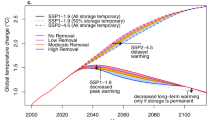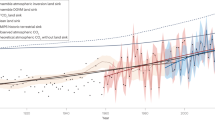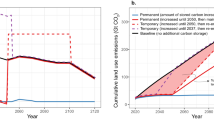Abstract
Depletion of ecosystem carbon stocks is a significant source of atmospheric CO2 and reducing land-based emissions and maintaining land carbon stocks contributes to climate change mitigation. We summarize current understanding about human perturbation of the global carbon cycle, examine three scientific issues and consider implications for the interpretation of international climate change policy decisions, concluding that considering carbon storage on land as a means to 'offset' CO2 emissions from burning fossil fuels (an idea with wide currency) is scientifically flawed. The capacity of terrestrial ecosystems to store carbon is finite and the current sequestration potential primarily reflects depletion due to past land use. Avoiding emissions from land carbon stocks and refilling depleted stocks reduces atmospheric CO2 concentration, but the maximum amount of this reduction is equivalent to only a small fraction of potential fossil fuel emissions.
This is a preview of subscription content, access via your institution
Access options
Subscribe to this journal
Receive 12 print issues and online access
$209.00 per year
only $17.42 per issue
Buy this article
- Purchase on Springer Link
- Instant access to full article PDF
Prices may be subject to local taxes which are calculated during checkout

Similar content being viewed by others
Change history
20 August 2013
In the version of this Perspective originally published, in Table 2, section (c), the fossil fuel carbon emissions were incorrectly described in the Land and Ocean categories. This error has now been corrected in the HTML and PDF versions.
References
Friedlingstein, P. et al. Update on CO2 emissions. Nature Geosci. 3, 811–812 (2010).
Houghton, R. A. Balancing the global carbon budget. Annu. Rev. Earth Planet. Sci. 35, 313–347 (2007).
Global Forest Resources Assessment 2010: Main Report Forestry Paper 163 (FAO, 2010).
Asner, G. P. et al. High-resolution forest carbon stocks and emissions in the Amazon. Proc. Natl Acad. Sci. USA 107, 16739–16742 (2010).
Vieweg, M. et al. Climate Action Tracker Update, 3 September 2012 (Climate Action Tracker, 2012); available via http://go.nature.com/CXg1v1
Shine, K. P., Derwent, R. G., Wuebbles, D. J. & Morcrette, J. J. in IPCC First Assessment Report 1990: Scientific Assessment of Climate Change (eds Houghton, J. T., Jenkins, G. J. & Ephraums, J. J.) 45–68 (Cambridge Univ. Press, 1990).
Solomon, S., Plattnerb, G., Knuttic, R. & Friedlingstein, P. Irreversible climate change due to carbon dioxide emissions. Proc. Natl Acad. Sci. USA 106, 1704–1709 (2009).
Archer, D. & Brovkin, V. The millennial atmospheric lifetime of anthropogenic CO2 . Climatic Change 90, 283–297 (2008).
Archer, D. et al. Atmospheric lifetime of fossil fuel carbon dioxide. Annu. Rev. Earth Planet. Sci. 37, 117–34 (2009).
Matthews, H. D. & Caldeira, K. Stabilizing climate requires near-zero emissions. Geophys. Res. Lett. 35, L04705 (2008).
Allen, M. R. et al. Warming caused by cumulative carbon emissions towards the trillionth tonne. Nature 458, 1163–1166 (2009).
Roxburgh S. H. et al. Organic carbon partitioning in soil and litter in subtropical woodlands and open forests: A case study from the Brigalow Belt, Queensland. Rangeland J. 28, 115–125 (2006).
House, J. I., Prentice, I. C. & Le Quéré, C. Maximum impacts of future reforestation or deforestation on atmospheric CO2 . Glob. Change Biol. 8, 1047–1052 (2002).
Prentice, I. C. et al. in IPCC Climate Change 2001: The Scientific Basis (eds Houghton, J. T. et al.) 183–238 (Cambridge Univ. Press, 1990).
World Population Prospects: The 2010 Revision, Highlights and Advance Table Working Paper No. ESA/P/WP.220 (United Nations, 2011).
World Energy Outlook 2006 (OECD/IEA, 2006).
Keith, H., Mackey, B. & Lindenmayer, D. Re-evaluation of forest biomass carbon stocks and lessons from the world's most carbon-dense forests. Proc. Natl Acad. Sci. USA 106, 11635–11640 (2009).
Carbon budget 2010 (Global Carbon Project, 2011); available at http://www.globalcarbonproject.org/carbonbudget/12/hl-full.htm
Denman, K. L. & Brasseur, G. in Climate Change 2007: The Physical Science Basis (eds Solomon, S. D. et al.) Ch. 7, 500–587 (Cambridge Univ. Press, 2007).
Friedlingstein, P., Dufresne, J. L., Cox, P. M. & Rayner, P. How positive is the feedback between climate change and the carbon cycle? Tellus B 55, 692–700 (2003).
Norby, R. J. et al. Forest response to elevated CO2 is conserved across a broad range of productivity. Proc. Natl Acad. Sci. USA 102, 18052–18056 (2005).
Hickler, T. et al. CO2 fertilization in temperate FACE experiments not representative of boreal and tropical forests. Glob. Change Biol. 14, 1531–1542 (2008).
Richard, J. et al. CO2 enhancement of forest productivity constrained by limited nitrogen availability. Proc. Natl Acad. Sci. USA 107, 19368–19373 (2010).
Luyssaert, S. et al. Old-growth forests as global carbon sinks. Nature 455, 213–215 (2008).
Lewis, S. L. et al. Increasing carbon storage in intact African tropical forests. Nature 457, 1003–1006 (2009).
Dean, C., Wardell-Johnson, G. & Kirkpatrick, J. B. Are there any circumstances in which logging primary wet-eucalypt forest will not add to the global carbon burden? Agric. For. Meteorol. 161, 156–169 (2012).
Liao, C., Luo, Y., Fang, C. & Li, B. Ecosystem carbon stock influenced by plantation practice: Implications for planting forests as a measure of climate change mitigation. PLoS ONE 5, e10867 (2010).
Danielsen, F. et al. Biofuel plantations on forested lands: Double jeopardy for biodiversity and climate. Conserv. Biol. 23, 348–358 (2009).
Kanowski, J. & Catterall, C. P. Carbon stocks in above-ground biomass of monoculture plantations, mixed species plantations and environmental restoration plantings in north-east Australia. Ecol. Restor. Manag. 11, 119–126 (2011).
Thompson, I., Mackey, B., McNulty, S. & Mosseler, A. Forest Resilience, Biodiversity, and Climate Change. A Synthesis of the Biodiversity/Resilience/Stability Relationship in Forest Ecosystems Technical Series No. 43 (Secretariat of the Convention on Biological Diversity, 2009).
Bates, B. C., Kundzewicz, Z. W., Wu, S. & Palutikof, J. P. (eds) IPCC: Climate Change and Water (IPCC Secretariat, 2008).
Scholze, M., Knorr, W., Arnell, N. W. & Prentice, I. C. A climate-change risk analysis for world ecosystems Proc. Natl Acad. Sci. USA 35, 13116–13120 (2006).
Friedlingstein, P. et al. Climate–carbon cycle feedback analysis: Results from the C4MIP model intercomparison. J. Climate 19, 3337–3353 (2006).
Report of the Conference of the Parties on its seventh session, held at Marrakesh from 29 October to 10 November 2000. Addendum Part Two: Action taken by the Conference of the Parties Volume I Annex C, Article 3, Paragraph 4 59 (UNFCCC 2000); available via http://go.nature.com/mmdUno
Neeff, T., Heiner von Luepke, H. V. & Schoene, D. Choosing a Forest Definition for the Clean Development Mechanism Forests and Climate Change Working Paper 4 (FAO, 2006); available via http://go.nature.com/Kl6NQh
Sasaki, N. & Putz, F. E. Critical need for new definitions of “forest” and “forest degradation” in global climate change agreements. Conserv. Lett. 2, 226–232 (2009).
Sustainable Forest Management Appendix 2: Data Tables (Forestry Tasmania, 2012); available via http://go.nature.com/2ymgMY
Harmon, M. E., Ferrell, W. K. & Franklin, J. F. Effects of carbon storage of conversion of old-growth forests to young forests. Science 247, 699–702 (1990).
Report of the Conference of the Parties Serving as the Meeting of the Parties to the Kyoto Protocol on its Seventh Session, Held in Durban from 28 November to 11 December 2011 Addendum Part Two Annex A–E (UNFCCC, 2011); available via http://go.nature.com/A6gdR3
Carbon Credits (Carbon Farming Initiative) Act 2011 (Australian Government, 2011); available via http://go.nature.com/n1exIb
Coulter L., Canadell, P. & Dhakal, S. Carbon reductions and offsets Report No. 6 (Global Carbon Project, 2007); available via http://go.nature.com/A8zsz3
Denman, K. L. & Brasseur, G. in IPCC Climate Change 2007: The Physical Science Basis (eds Solomon, S. D. et al.) 515 (Cambridge Univ. Press, 2007).
Olofsson, J. & Hickler, T. Effects of human land-use on the global carbon cycle during the last 6,000 years. Veget. Hist. Archaeobot. 17, 605–615 (2008).
Plattner, G. K. et al. Long-term climate commitments projected with climate–carbon cycle models. J. Clim. 21, 2721–2751 (2008).
Le Quéré, C. Trends in the sources and sinks of carbon dioxide. Nature Geosci. 2, 831–836 (2009).
Le Quéré, C. et al. The global carbon budget 1959–2011. Earth Syst. Sci. Data Discuss. 5, 1107–1157 (2012).
Author information
Authors and Affiliations
Corresponding author
Ethics declarations
Competing interests
The authors declare no competing financial interests.
Rights and permissions
About this article
Cite this article
Mackey, B., Prentice, I., Steffen, W. et al. Untangling the confusion around land carbon science and climate change mitigation policy. Nature Clim Change 3, 552–557 (2013). https://doi.org/10.1038/nclimate1804
Received:
Accepted:
Published:
Issue Date:
DOI: https://doi.org/10.1038/nclimate1804



